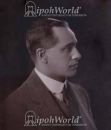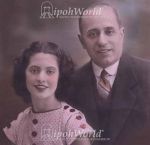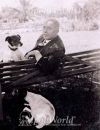We've tried to ensure the information displayed here is as accurate as possible. Should there be any inaccuracies, we would be grateful if you could let us know at info@ipohworld.org . All images and content are copyright.
(Please click on the thumbnail for a bigger image.)
Pierre Z Creet - Founder Of The Grand Hotel, Ipoh



The Story of Pierre Z (probably Zacharia) Creet starts in Isfahan (or Esfahan) in Persia, now Iran. He was an Armenian born to Zacharia and Takouyee (aka Virginie) Creet on 16 January 1881. He had at least two brothers, Makertich and Simon, both of which were closely associated with him in later in life in Malaya. It is suggested by Nadia H Wright in her book “Respected Citizens” that they may have been related to the Sarkies brothers, famous for the Raffles Hotel, Singapore and the E&O, Penang. From a study of the history in Malaya, it is clear that, related or not, Pierre and his brothers were certainly very close to the Sarkies.
Nadia also relates that Pierre left home at age 16 and spent the next two years in India, probably completing his education at the Armenian College in Calcutta. He then (in 1899?) took passage to Singapore in order to start his training in hotel management at the Raffles Hotel. Around 1900 he was transferred to the E&O, Penang. He remained there as one of the management staff, until 1909.
Here again enters the involvement of the Sarkies brothers for in late 1907/early 1908 they entered negotiations with the government to build their third luxury Malayan hotel, this time in Ipoh. They were not the only contenders, but favoured by the authorities, they were offered a 99 year lease on a large, choice piece of land in a prime position, almost right opposite the railway station (where the Supreme Court stands today). They accepted and in May 1908, after much consideration, they started to plan their new hotel and demolish the existing building that stood on their new site. This latest venture was to exceed the grandeur of both the Singapore and Penang hotels. The architects were Messrs Drapers, Williams and Steadman, a well known local company at the time. This was basically a Singapore firm formed in Ipoh, in that same July of 1907, when Charles Williams and Basil Draper took in Vincent Steadman as a partner and sent him up to Ipoh to open up a branch office — to oversee the construction of the Birch Memorial Clock Tower.
However, just six months later, the price of tin (Ipoh’s great asset) fell dramatically as it often did and the Sarkies pulled out of their government contract in fear that this time it might bring about a long recession from which it might never recover. This left the field open for another entrepreneur to step in.
By this time, Pierre Creet had been working closely with the Sarkies for several years and, as manager of the E&O, must have been party to all the ups and downs of their Ipoh project. Consequently he was perfectly placed to step into the void and start a hotel in their place, but obviously he could not afford to build a palatial Raffles look-alike from scratch. So he did the next best thing by leasing an existing building, the grand home of the late Dato’ Muda Wahab on Lahat Road, Ipoh. At the time the house belonged to Dato’ Sri Adika Rajah, Wan Mohamed Salleh who had married Toh Puan Sharifah Rodiah, the widow of Dato’ Muda Wahab. The lease ran from the 1st December 1909 and he called the project the “Grand Hotel.” It opened on 16th December 1909 and was Ipoh’s first European style hotel and grand it was.
Now Pierre was an astute businessman who had probably learnt a lot during his close relationship with the Sarkies brothers and so for the formal opening of the Grand, he invited all the high Government officials and assured them that if the Government Rest House was closed, he would reserve certain rooms for them at the same cost as they paid there, so that they would not be out of pocket. There was also a select group of affluent guests, the membership of the Perak Turf Club that he cosseted and spoilt for they were the big spenders.
With all his business acumen put into action and just a five minutes ride by rickshaw from the Railway Station, situated close to both the administrative and commercial centres and with twenty fine bedrooms and en-suite bathrooms, a spacious bar, a billiard room, a cosy morning room, a special planter’s and miner’s lounge, smoking rooms and a motor garage for the very rich, the Grand could not fail. This was luxury indeed for the colonials who before that had had to suffer the Government Rest House or risk one of the smaller Chinese-run establishments.
But Pierre did not stop there for he believed in advertising, his motto being:
Early to bed and early to rise,
Is of no d----d use if you don’t advertise.
Consequently, with memorable advertising, business just rocketed and less than 12 months later he had to build a new wing with twenty-two more rooms, this time not only with the en-suite bathroom but also a private sitting room. Not surprisingly they were of a strikingly similar design to the E & O, Penang. Although not the Raffles nor the E&O, the Grand Hotel, Ipoh ranked equally with them, the finest in the Straits Settlements and Federated Malay States.
More bedrooms followed, funded by Dato’ Sri Adika Raja; in 1912 ten more were added, each with a verandah and lit by “Simpetrol” gas; then a year later he built another annexe, this time with ten rooms and a large dining room, entirely lit by electricity. Could nothing stop Pierre Z Creet?
The Grand Hotel in Ipoh, with no real competition, ruled the roost. There were billiard competitions with silver cups for the winners, fancy dress balls, special functions for Christmas and New Year and Dinners-and-Dances with the Perak State Band providing the music. Of course the mandatory dress requirement was ‘black tie’ and caviar was regularly served. What else would a high-class international hotel serve their clientele. Local people were not expected to appear except as members of the staff through the back door!
But the most splendid of all the grand functions was dinner organised by Creet to celebrate the Coronation of King George V in 1911. Ipoh was in the middle of a tin and rubber boom and expense was no object. It was reported in the Perak Pioneer thus:
AL FRESCO DINNER To Mr P Z Creet, proprietor of the Grand Hotel, was left the honour of winding up the Coronation celebrities in Ipoh, and the dinner he served on one of the spacious lawns of the Grand Hotel on Saturday night was one of the best dinners, if not the best, we have ever partaken of in Asia, and our experience of tip-top hotel dinners East of Suez, covers the leading hotels of Calcutta, Madras, Rangoon and Singapore.
The menu was a monster one, covering no less than twenty items. The Perak State Band was in attendance and played some delightful selections of music during the dinner.
There were over 1,000 lanterns alight in the grounds of the Grand Hotel on Saturday night. Everyone was struck with the magnificence of the illuminations. The spacious grounds of the Hotel looked like a fairyland, the red and yellow glow of the lanterns showing up well against the green of the velvety lawns and the waving palm fronds. Indeed, so brilliant were the illuminations that hundreds of natives were attracted to the vicinity of the hotel and stood outside watching the Ang Mohs at makan (note: white men eating).
The locals simply stood outside the fence watched in amazement as some 80 Europeans, resplendent in full evening dress, gorged themselves silly. Such was the divide between colonials and Malayans in those far-off days.
But behind the scenes in 1912 there were already financial difficulties on the horizon. The chit system (signing for drinks and paying monthly) was not working to Pierre’s advantage, but when he stopped it many regulars stopped dropping in, preferring the Ipoh Club which even today (2010) still operates on chits. He then reduced the room rates in 1914, but that did not help either and profits worsened. In 1910 he had branched out, buying the FMS hotel in Kuala Lumpur, and installimg a new manager, Sakooly Martin (another Armenian) and renamed it the Grand Oriental. Both hotels were run on similar lines and grandeur was the requirement of the day.
Not long after the opening of the Grand in Ipoh, Pierre had been joined by his brothers, Makertich as Assistant Manager, and Simon who had spent three years on the staff of Raffles (1907 to 1910). They both stayed at the Grand for about three years, but when the hotel’s financial viability became a concern they both left for pastures new for this was the time of cutbacks and economies. At around that time (1913) Pierre was also assisted at the Grand by another Armenian, Malcolm Catchick Gasper. On leaving Pierre he remained in the industry in Malaya and Singapore, was captured by the Japanese and died in an internment camp on 24 July 1945.
Makertich Creet moved to Penang in 1913 and took over as manager of the Hotel Norman, established originally (in 1910) as the FMS Raffles Hotel, a name they were forced by the Sarkies to relinquish in the courts, renaming it the Norman. On leaving this position he moved to India, married, had five children and then divorced. He then returned to his roots, Julfa, an Armenian district of Isfahan and remarried.
Simon Creet on the other hand returned to Raffles and the Sarkies where he spent another two years before moving to Macassar, Western Cape, South Africa where he was able to run his own hotel.
However, it is said that good things always come to an end and for Pierre it was the building of Ipoh’s new railway station in 1917 with its comfortable, but far from luxurious, station hotel built above the station entrance, combined with the earlier financial difficulties and the reduction in guests due to the world war, that brought about his downfall. This Station Hotel was government run and was therefore much cheaper than the Grand and times were tough. It therefore forced him out of business at the end of June 1918. Both the Grand and the Grand Oriental were lost to him.
But there was still life in Pierre, who despite the worries of the diminishing fortunes of his favourite Grand had fallen madly in love with a beautiful Australian, Alma Crawley, who had dropped in to Penang during a grand tour. She had dazzling blue eyes and a beautiful voice that completely won him over. It was a whirlwind courtship and Nadia Wright records that he proposed to her and she accepted before her ship sailed from Penang. Leaving his hotels behind, he had no qualms about catching a ship to Sydney, arriving there in November 1918. They were married less than six weeks later. However they were divorced in 1935, their only daughter Mignon Patricia (known as Betty to her friends) Creet being 13 at the time. During his marriage he continued to work in the hotel industry and in 1928 took over the Hydro Hotel, Leeton, New South Wales as licensee. After the divorce, daughter Mignon is believed to have lived there with him.
During the war, Mignon married an RAAF fighter pilot, in the same church where, a decade later, her father’s funeral service would be held, and in 1943 she moved to Sydney with her father, where he became proprietor of the Hotel Cecil. He lived there with his second wife, Esme Gavin, who Pippa our donor suggests may have been his secretary at one time, until he passed away in 1951. Mignon became a published poet and fiction writer and settled in London. She has since passed away.
The above is an amalgam of information taken from The Times of Malaya and The Perak Pioneer, the two earliest newspapers in Perak, together with detail from “Respected Citizens” by Nadia Wright and "Ipoh When Tin was King" by local historian Dr Ho Tak Ming.
The photographs are provided by Pippa Ettore, granddaughter of Pierre. They show, from left to right:
To see a photograph of the Grand Hotel, click here.
To find out more about the book "Respected Citizens", click here.
To read more about the Times of Malaya, click here.
To read more about the Perak Pioneer, click here.
To read more about Dato’ Sri Adika Raja, click here.
To read about "When Tin Was King", click here.